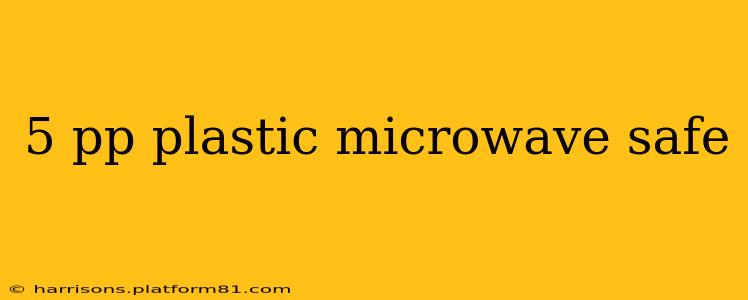Finding microwave-safe plastic containers can be tricky. The ubiquitous "5" symbol on plastic often sparks confusion – is it microwave-safe? This guide delves into the specifics of 5-PP plastic and its suitability for microwave use, addressing common questions and concerns.
What Does "5-PP" Mean on Plastic?
The "5" within a recycling symbol on plastic indicates that the item is made from polypropylene (PP). Polypropylene is a thermoplastic polymer known for its versatility, strength, and resistance to heat and chemicals. This makes it a popular choice for food storage containers, bottles, and other kitchenware. However, the microwave safety of PP depends on several factors.
Is 5-PP Plastic Always Microwave Safe?
No. While polypropylene generally withstands higher temperatures than some other plastics, not all 5-PP containers are designed for microwave use. The crucial factor is the manufacturer's labeling. Always check the container for specific microwave-safe instructions. The presence of the number 5 alone isn't sufficient assurance. Look for explicit statements indicating microwave suitability.
What are the safe temperatures for using PP plastic in the microwave?
The safe temperature range for polypropylene in a microwave generally falls between 0°C (32°F) and 100°C (212°F). However, exceeding these temperatures for prolonged periods could potentially leach chemicals into food. It's crucial to avoid overheating or prolonged microwaving, even if the container claims to be microwave-safe.
Can I Put Empty 5-PP Plastic Containers in the Microwave?
Yes, generally speaking, empty 5-PP containers marked as microwave-safe can be safely heated in a microwave. However, it's always best to follow the manufacturer's instructions. Overheating an empty container can still damage it, even if it won't leach chemicals into food.
What Happens If I Microwave 5-PP Plastic That Isn't Microwave Safe?
Microwaving 5-PP plastic that's not designed for it could lead to several undesirable outcomes:
- Warping or Melting: The plastic might deform or melt, rendering the container unusable.
- Chemical Leaching: Heat can cause chemicals from the plastic to leach into the food, potentially posing health risks.
- Off-flavors: The heated plastic might impart unpleasant tastes or odors to your food.
Always prioritize safety and use only containers explicitly labeled as microwave-safe.
How Can I Tell if My 5-PP Plastic Container is Microwave Safe?
Look for clear labeling on the container itself. The manufacturer's instructions should explicitly state whether it's safe for microwave use. If there's no such indication, err on the side of caution and do not microwave it.
Are there better alternatives to 5-PP plastic for microwave use?
Several materials are better suited for microwave use than some 5-PP plastics. These include:
- Glass: Glass is an excellent choice for microwave cooking and reheating.
- Microwave-safe ceramics: Many ceramic dishes are explicitly designed for microwave use.
- Silicone: Silicone is another heat-resistant material that's commonly used in microwave-safe cookware.
Using appropriate microwave-safe containers ensures both food safety and the longevity of your kitchenware. Always check the label for clear instructions before using any plastic container in a microwave. Prioritizing safety ensures you can enjoy your meals without compromising your health.
